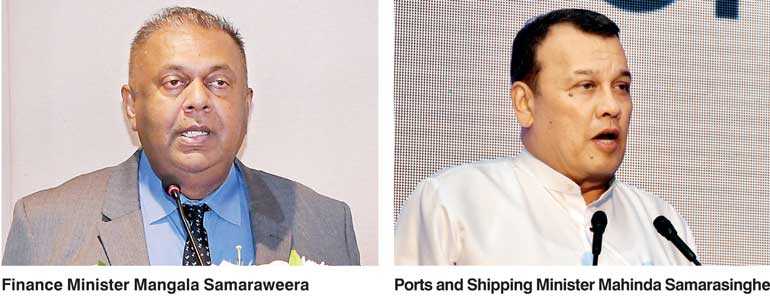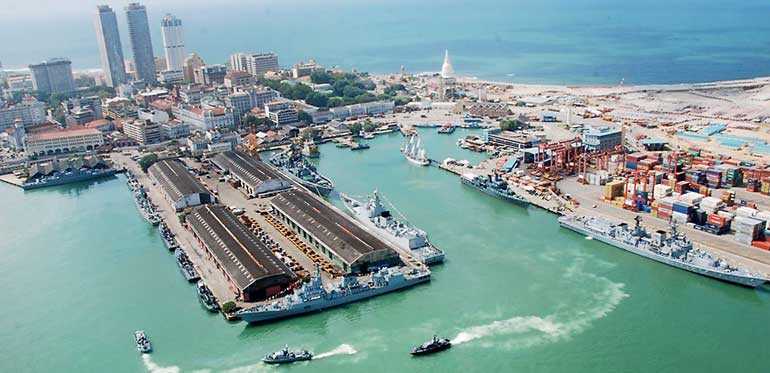Monday Mar 17, 2025
Monday Mar 17, 2025
Monday, 15 October 2018 00:00 - - {{hitsCtrl.values.hits}}

Sri Lanka’s Finance Minister Mangala Samaraweera wrapped up the 2018 budget debate promising to end the country’s ‘nanny state’ approach, and expressed his determination to press ahead with radical liberalisation. He went on to say, “To do this we must be open to global trade, embrace competition and take on the world and win. Whilst the government will not be a nanny state, we do not forget the vulnerable and those who need the support of the State.”
Brave words no doubt, heralding a much needed change in overall approach. Among the industries targeted by the Minister for liberalisation was the shipping sector. What would this entail?
The protectionist era
 In the 60s and 70s, protection in shipping was the name of the game. Developing countries were eager to develop their national merchant fleets, and their efforts were encouraged and supported by UNCTAD’s Code of Conduct for Liner Conferences, that proposed a cargo split of 40:40:20, with the higher proportion to the respective fleets of the trading partners, and the lower percentage to third flag carriers. It was a radical move.
In the 60s and 70s, protection in shipping was the name of the game. Developing countries were eager to develop their national merchant fleets, and their efforts were encouraged and supported by UNCTAD’s Code of Conduct for Liner Conferences, that proposed a cargo split of 40:40:20, with the higher proportion to the respective fleets of the trading partners, and the lower percentage to third flag carriers. It was a radical move.
Sri Lanka was in the forefront of this development, with the establishment of the Ceylon Shipping Corporation (CSC) in 1971 and the Central Freight Bureau (CFB) in 1973. The CFB was the first organisation among the developing countries to have a mechanism in the form of a central freight booking office, which had the ability to allocate cargo following the guidelines of the UNCTAD Code. The CFB model was adopted by several developing countries with the technical assistance of CFB officials. CSC modernised its fleet from break bulk to containers and dominated the Sri Lankan market, and also performed creditably in the India- Pakistan to Europe Trade against fierce foreign competition.
However, with the winds of change ushering in open economic policies in Sri Lanka as well as in many developing countries, protection for shipping in international trades began to lose its lustre. Sri Lankan policymakers adapted to the change, and the CFB was disbanded in the early 90’s. CSC was unable to weather the heightened level of competition (a period in which several carriers ceased to exist) and departed from liner shipping in the mid-90s.
Sri Lanka’s import & export trades were fully opened up for free competition. Any shipping line was able to call at Sri Lankan ports, and shippers were free to make their choice of carrier at freight rates determined by market forces, and the lines were permitted to select a local agent of their choice. Shipping was liberalised.
Ports and terminals
Not to be outdone, Sri Lanka’s Ports & Terminal sector also ushered in change. The Sri Lanka Ports Authority (SLPA) was formed in 1979, and controlled all port & terminal activity. In 1999 the SLPA agreed to a 30 year BOT concession agreement with a consortium of foreign and local investors to set up the South Asia Gateway Terminal (SAGT). This was one of the largest foreign investments in Sri Lanka and was completed in three phases in 2003. The investors in SAGT were: A.P. Moller Group; Evergreen International SA; Peony Investments SA; John Keells Holdings PLC; and Sri Lanka Ports Authority.
SLPA is a minority shareholder. With this development, the ports and terminal sector was liberalised.
SLPA went one step further, signing a 35 year BOT agreement which saw the Colombo International Container Terminal (CICT) come on stream in 2013. China Merchants Port Holdings Company owns 85% of CICT’s shares, with SLPA holding the balance.
In December 2017, SLPA agreed to a 99 year lease of the Southern Port of Hambantota to China Merchants Ports Holding for $ 1.12 billion - Sri Lanka’s largest foreign direct investment in the maritime sector.
In the first half of 2018, Colombo had the highest growth level of any global port compared to the same period in the prior year. Its transshipment volumes during this period had an impressive growth of 19.8%.
The downside to this feel-good story is that the Port of Colombo is almost at full capacity with no room for expansion until the East Container Terminal is operational. The country’s desire for greater foreign earnings and investment would be satisfied if this project is fast-tracked.
Nine foreign investors have expressed an interest in investing in the East Container Terminal.
SLPA has an ambitious expansion project on the drawing boards that could attract further foreign investment.
What remains to be liberalised?
All the ballyhoo about liberalisation comes down to a relatively insignificant aspect of shipping - the shareholding of local shipping agents.
The global container shipping industry has been highly unprofitable in the past few years. Earnings have been exceptionally volatile despite volume growth. Some of the pain is self-inflicted through the penchant to gain market share by adding capacity through often unneeded new and larger vessels. This scenario has forced several carriers to merge with their larger brethren for survival. Some such as Korean giant Hanjin did in fact go out of business, stranding thousands of laden containers throughout the world.
Carrier consolidation has led to the TOP 6 having a market share of over 70%.
Carrier market share
APMMaersk 17.8%
Mediterranean Shipping Company 14.4%
COSCO Group 12.3%
CMA-CGM Group 11.7%
Hapag Lloyd 7.1%
ONE (Ocean Network Express) 6.8%
Consequently, when blame is cast on local shipping agents for cartelisation, the reality is that carrier consolidation has forced the concentration of agencies among a few companies - a development completely out of the control of local companies.
The Ceylon Association of Shipping Agents (CASA) has over 130 members, and competition for agency business is fierce and ever present, bearing in mind that large carriers require agents with the required organisation to support their business. The proposed liberalisation would raise the current limitation of foreign ownership of local shipping agents from 40% shareholding up to 100%.
Should this proposal be implemented, it would kill the local agency business that has been the cornerstone of maritime development in the country for the past 50 years. It is an industry that Sri Lanka should be proud of, and could continue to be a catalyst for enhancing Colombo’s status as a maritime hub.
The following results detrimental to the national interest are likely to occur, should the agency business be liberalised:
It is clear that the negatives far outweigh any positives in allowing foreign control of agencies.
All the major carriers are already present in Sri Lanka. Liberalisation would not bring in any newcomers.
Furthermore, local agents have no authority to fix freight rates. Pricing is the exclusive preserve of the Principals. Hence, liberalisation will not intensify competition or lower freight rates. The converse maybe true as local agents do currently espouse the cause of shippers with their Principals for favourable treatment based on the merits of the case.
Foreign influence
It is clear that the European Union is funding the lobbying efforts for agency liberalisation, as four of the six major carriers are European companies. It is important to recognise that protection in shipping is alive and well in several EU countries in the area of Cabotage, which is very detrimental to connectivity and efficiency in container shipping. So is the case with the United States, China, and several other developed market economies. Hence, the Ministry of Finance may wish to re-think the subject before killing the goose that lays the golden egg!
The writer is Principal, Cranford Consulting Inc., and a former President of United Arab Shipping Company (North America) and General Manager of the Central Freight Bureau of Sri Lanka and the Ceylon Shipping Corporation.

Discover Kapruka, the leading online shopping platform in Sri Lanka, where you can conveniently send Gifts and Flowers to your loved ones for any event including Valentine ’s Day. Explore a wide range of popular Shopping Categories on Kapruka, including Toys, Groceries, Electronics, Birthday Cakes, Fruits, Chocolates, Flower Bouquets, Clothing, Watches, Lingerie, Gift Sets and Jewellery. Also if you’re interested in selling with Kapruka, Partner Central by Kapruka is the best solution to start with. Moreover, through Kapruka Global Shop, you can also enjoy the convenience of purchasing products from renowned platforms like Amazon and eBay and have them delivered to Sri Lanka.
Discover Kapruka, the leading online shopping platform in Sri Lanka, where you can conveniently send Gifts and Flowers to your loved ones for any event including Valentine ’s Day. Explore a wide range of popular Shopping Categories on Kapruka, including Toys, Groceries, Electronics, Birthday Cakes, Fruits, Chocolates, Flower Bouquets, Clothing, Watches, Lingerie, Gift Sets and Jewellery. Also if you’re interested in selling with Kapruka, Partner Central by Kapruka is the best solution to start with. Moreover, through Kapruka Global Shop, you can also enjoy the convenience of purchasing products from renowned platforms like Amazon and eBay and have them delivered to Sri Lanka.